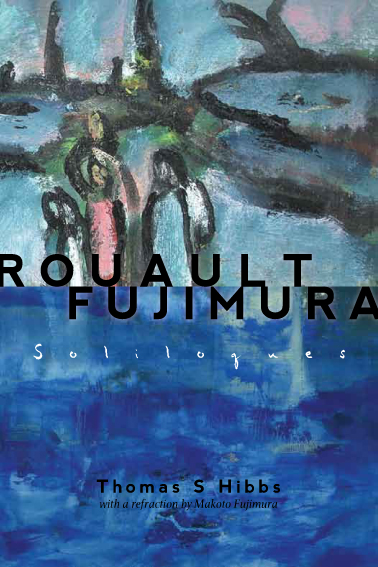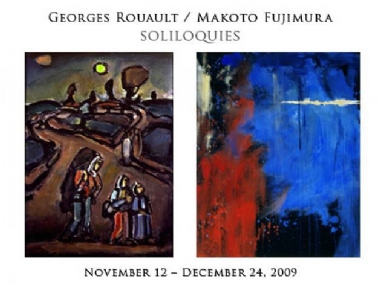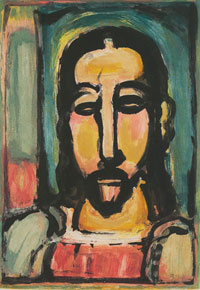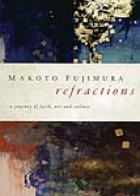Occasionally we get to announce to the world (or at least anybody following this feeble little blog) something truly historic. And in this case, dear readers, it not only is historic—that is, of great historic significance–but it is uniquely an offering of Hearts & Minds. We are currently the only bookstore stocking a brand new book, and this brand new book commemorates and participates in something rare and good and beautiful. This really is big news, and something very, very special.
 Come on man, you’re thinking, get on with it. What is worthy of this sort of acclaim and suspense? Just tell us about the thing. Well, surely your eye has already seen the headline announcement, and you can’t miss the book-cover, so you can see it is called Rouault Fujimura Soliloquies (Square Halo Press; $19.99.) Let me try to explain its heady significance.
Come on man, you’re thinking, get on with it. What is worthy of this sort of acclaim and suspense? Just tell us about the thing. Well, surely your eye has already seen the headline announcement, and you can’t miss the book-cover, so you can see it is called Rouault Fujimura Soliloquies (Square Halo Press; $19.99.) Let me try to explain its heady significance.
Do you know the famous French painter Georges Rouault (1871-1958)? Do you know the contemporary New York artist Makato Fujimura? The prestigious Dillon Gallery in Manhattan has opened a thrilling–yes! historic!—exhibit of paintings by Georges Rouault and recent ones done in the neo-abstract style of Mr. Fujimura who has been influenced by the seventh century Japanese Rimpa tradition and the techniques of Nihonga (of which he is a current master.) These brand new works by Fujimura (completed in the late fall of 2009 in time for the show) were largely, in ways conscious and subconscious (I gather) influenced by and in response to the body of Rouault’s work. It is homage and more. Displaying them together in this innovative exhibition, one critic writes, “has added an important dimension to the current reappraisal of Rouault, precisely by the juxtaposition of Rouault’s work with that of a contemporary artist who claims him as an influence.”

Not only is this a major showing of the world famous Frenchman (and an impressive body of very new work by Fujimura) it seems that some of the Rouault paintings are being shown publicly for the first time. Although the story may be more interesting than this short telling, Mr. Fujimura has become friends with the family of the Rouault estate. He has visited the esteemed painter’s Gare de Lyon studio, has become familiar with the environment and family of the man who was a contemporary of, and influence upon, Picasso, Matisse, even Cezanne. That this youngish, evangelical, Japanese-American New Yorker would gain trusted access from the grandchildren of this French intellectual Catholic–who often sought out the poor, the marginalized, the odd and sad—is remarkable, and a fabulous backstory to this emerging work. In other words, Mako seems to have gotten them not only to allow him access, but to send paintings over to be displayed in New York, and the electronic files of the photos of them to the Square Halo office in Pennsylvania to be made into a new art book. Hence, Rouault Fujimura.
 Kudos to Square Halo Press’s main man Ned Bustard for his speedy and ingenious design and arrangement of this small book, doing the lay-out with files sent from Paris, handling pictures of Rouault works that few have seen. As he worked overtime to size up the color and tone and and allusive calibre of each work—early 20th century and early 21st century—Bustard prayerfully reflected on each painting, and how they could be featured alongside the two lengthy chapters of solid prose. The small handbook, printed well on glossy paper, a trim size, with very vivid coloration, is itself a work of art. Rouault Fujimura Soliloquies is a book worth owning even if one cannot get to New York to see this important contribution to contemporary art. In fact, it is worth owning if you don’t know anything about any of this. What a beautiful and moving way to get a small bit of art education. What a great gift for any art lover or student.
Kudos to Square Halo Press’s main man Ned Bustard for his speedy and ingenious design and arrangement of this small book, doing the lay-out with files sent from Paris, handling pictures of Rouault works that few have seen. As he worked overtime to size up the color and tone and and allusive calibre of each work—early 20th century and early 21st century—Bustard prayerfully reflected on each painting, and how they could be featured alongside the two lengthy chapters of solid prose. The small handbook, printed well on glossy paper, a trim size, with very vivid coloration, is itself a work of art. Rouault Fujimura Soliloquies is a book worth owning even if one cannot get to New York to see this important contribution to contemporary art. In fact, it is worth owning if you don’t know anything about any of this. What a beautiful and moving way to get a small bit of art education. What a great gift for any art lover or student.
Although one must affirm that the paintings themselves (as I have said, some rather rare from the Rouault family estate and some brand new from Mr. Fujimura) appear as the heart of Soliloquies, the accompanying text is sublime, informed, insightful, dense. Thomas S. Hibbs has a long essay explaining who these two artists are, the nature of their projects, why it is so very interesting to juxtaposition them, and how the older Catholic, doing modern art rooted in the tradition of medieval stained glass work, so influenced the younger Presbyterian, doing modern art rooted in the tradition of ancient Japanese stylings. Both, Hibbs explains, are working in contemporary ways with certain pre-modern manners, both intentionally spiritual; each, in their own way, deconstructing the very notions of “abstract” art. Both are, he suggests, working “from the margins.” Both are concerned about materials–that is they are not ethereal or Gnostic. Both have seen horrible things. (Mr. Rouault lived through Nazism and Mr. Fujimaro witnessed the bombing of his beloved Manhattan in September 2001.)
the Rouault family estate and some brand new from Mr. Fujimura) appear as the heart of Soliloquies, the accompanying text is sublime, informed, insightful, dense. Thomas S. Hibbs has a long essay explaining who these two artists are, the nature of their projects, why it is so very interesting to juxtaposition them, and how the older Catholic, doing modern art rooted in the tradition of medieval stained glass work, so influenced the younger Presbyterian, doing modern art rooted in the tradition of ancient Japanese stylings. Both, Hibbs explains, are working in contemporary ways with certain pre-modern manners, both intentionally spiritual; each, in their own way, deconstructing the very notions of “abstract” art. Both are, he suggests, working “from the margins.” Both are concerned about materials–that is they are not ethereal or Gnostic. Both have seen horrible things. (Mr. Rouault lived through Nazism and Mr. Fujimaro witnessed the bombing of his beloved Manhattan in September 2001.)
Hibbs quite appropriately draws into the conversations several European Catholic thinkers (such as Jacques Maritain, Etienne Gilson, Leon Bloy and Jean-Luc Marion.) He cites Augustine, Simon Weil and T.S. Eliot. His essay is learned and a true joy to read. (I am not well schooled in art history and only an amateur in social and cultural theory; I relished the chance to read this finely argued and mature study, learning much, without wading through a 500 page treatise.) Thomas Hibbs, who teaches at Baylor University, may be known to some of our readers as he has appeared on the popular Mars Hill Audio interviews with Ken Myers. We stock his book called Shows About Nothing which is a trenchant analysis of pop culture and nihilism. Hibbs is a serious man, it seems, and well suited to offer a dignified study of these two serious painters.

gly entitled “Georges Rouault: the First Twenty-First Century Artist.” He tells some tender stories about his work, his life, his own growth into what Rouault called a “terrible beauty.” (There are a few very nice photos of Mako looking at a Rouault work, and a close up of both of their desks and tools giving the book an intimate feel. A little secret: even the type font for certain headings and chapter titles is a typography designed from Mako’s own handwriting.)
This lovely and thoughtful chapter is somewhat like his other essays called “Refractions” found in his wonderful collection Refractions: A Journey of Faith, Art and Culture (NavPress; $24.95.) Fujimura is an excellent writer, a great teacher, a moving memoirist. We loved the book Refractions for his wonderful essays about culture, life, his work as an artist and how all of us might engage the world more thoughtfully and faithfully. I wrote a lot about it last March, for instance, here.
an excellent writer, a great teacher, a moving memoirist. We loved the book Refractions for his wonderful essays about culture, life, his work as an artist and how all of us might engage the world more thoughtfully and faithfully. I wrote a lot about it last March, for instance, here.
In Soliloquies, it is wonderful to have the painter offering an eloquant glimpse of his inner life and how he sees the world, inspired so by this painter who (unlike other impressionists) was drawn to use the color black.
Indeed, after citing a secular art critic who notes Rouault’s use of heavy black (along with very bright vivids) Mako writes,
One should not be surprised, in following Rouault, to find a philosopher like Yanagi, who does not identify himself as a Christian, write so eloquently of biblical realities. That, in essence, is the power of Rouault’s universe. He is not merely a “religious” painter: he was the painter of a greater generative Reality, of multiple colors behind our dark, foreboding and destructive world.
Soliloquies are not, Hibbs points out, the same as monologues. There is dialogue here, interaction. Certainly Fujimura is doing a homage. But, also, we see Rouault afresh in this setting. Both Hibbs and Fujimura explain how this is so. The reader of Rouault Fujimura Soliloquies has the privilege of being a conversation partner with text and art, reading and looking, studying and pondering, learning and enjoying. These discussions are on-going. We are very pleased to offer this Square Halo book in celebration of historic art from a previous generation, and historic art made this year. Congratulations to Mako, his IAM organization, the Dillon Gallery, and Square Halo Books. We are thrilled to be making this book available to the wider public. Spread the word. This has been–truly–historic. What a joy to be able to announce it here.
Soliloquies Special
10% off
regularly
$19.99
now
$17.99
Order Here
Hearts & Minds 234 East Main Street Dallastown, PA 17313 717.246.3333

I love this book as well and you captured the many reasons why I do. Thank you for your support and for the wonderful review….thanks kindly, Diana, Presdient Square Halo Books
Byron, I was reading about Renaissance Humanism this morning in a book on Jesuit Humanism and you are truly a man of letters and arts, the “umanistica” who is passionate about all areas of knowledge.
i passed on your review to an artist friend in europe.
grace,
brian